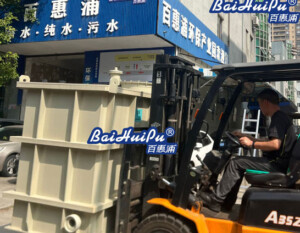厨房废水处理装置是用于处理餐厨垃圾产生的废水的装置。其重要性在于能够有效减少环境污染,实现资源循环利用。以下是厨房废水处理装置的详细介绍:
1. 主要类型
1. 一体化厨房废水处理设备:
本设备集多种处理工艺于一体,包括预处理、生化处理、沉淀、过滤等步骤,可实现废水的全面净化。
优点:占地面积小、处理效率高、作简单方便。
2、破脂技术处理设备:
对于含有大量动植物油的厨房废水,采用破脂技术进行处理。
优点:能高效去除油类和可溶性有机物,出水水质稳定,污泥出量小。
3. 机械与生物技术相结合的处理系统:
例如,珠海联谊机电打造的餐厨垃圾再生系统,通过机械预处理和生物技术将餐厨垃圾转化为浆料,然后进一步加工。
优点:自动化程度高,处理效率高,具有资源再利用能力(如生产沼气、高蛋白固体残留物等)。

2. 工作原理
The working principle of the kitchen wastewater treatment device usually includes the following steps:
1. Pretreatment: remove large particles of impurities and grease in the wastewater to prevent clogging of subsequent treatment equipment.
2. Biochemical treatment: use the metabolism of microorganisms to decompose organic matter in the wastewater and convert it into harmless substances.
3. Sedimentation: gravity causes suspended matter in the wastewater to settle to the bottom to form sludge.
4. Filtration: further remove suspended matter and tiny particles in the wastewater.
5. Disinfection: ultraviolet rays, ozone and other methods are used to kill bacteria and viruses in the wastewater to ensure the safety of the effluent water quality.
3. Advantages and characteristics
1. Space saving: the integrated equipment occupies a small area and is suitable for use in various places.
2. High treatment efficiency: the use of advanced treatment processes and technologies can quickly degrade organic matter in the wastewater.
3. Stable effluent water quality: after treatment, the water quality of the wastewater can meet the discharge standards or reuse requirements.
4. Low sludge production: Some equipment adopts advanced sludge reduction technology to reduce sludge generation and treatment costs.
5. High degree of automation: Adopt intelligent control system to realize automatic operation and monitoring of equipment.
IV. Application field
Kitchen wastewater treatment devices are widely used in various places where kitchen wastewater is generated, such as kitchens, restaurants, canteens, food processing plants, etc. At the same time, it is also suitable for urban sewage treatment plants, rural domestic sewage treatment and other fields.
V. Purchase suggestions
1. Understand the needs: Determine the type and specifications of the required equipment based on factors such as treatment volume, water quality requirements, and site conditions.
2. Compare performance: Compare the treatment efficiency, effluent water quality, operating cost and other indicators of equipment of different brands and models.
3. Investigate the manufacturer: Choose a qualified, experienced and after-sales guaranteed manufacturer for cooperation.
4. Sign a contract: Clarify the performance parameters, delivery time, after-sales service and other terms of the equipment to ensure the rights and interests of both parties.
Kitchen wastewater treatment devices play an important role in treating kitchen wastewater and protecting the environment. Choosing appropriate equipment and using it properly can effectively reduce environmental pollution and achieve resource recycling.